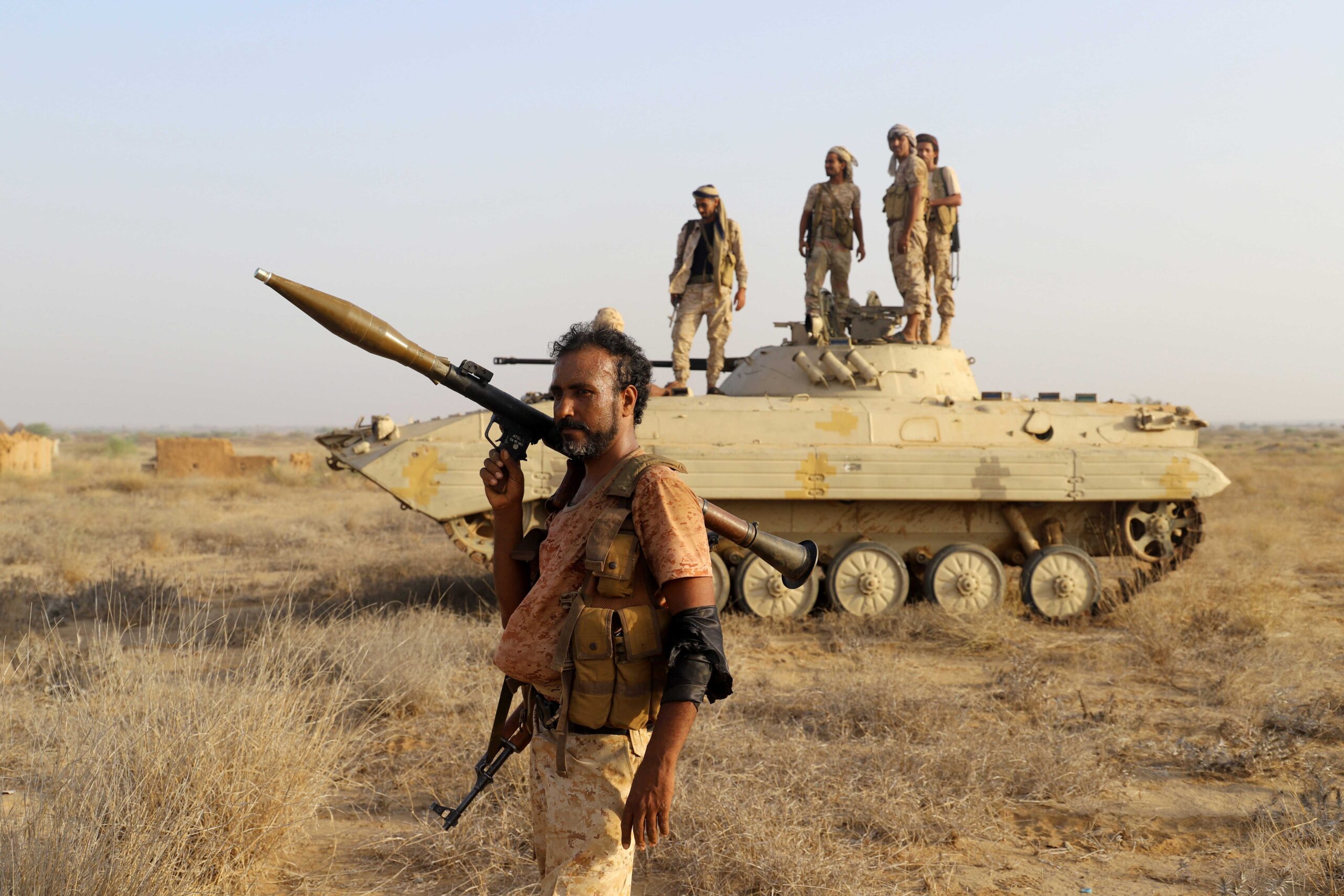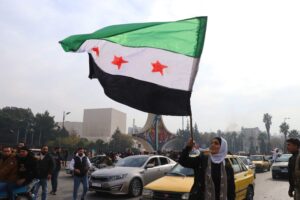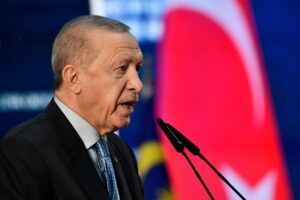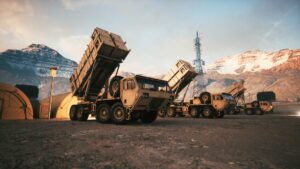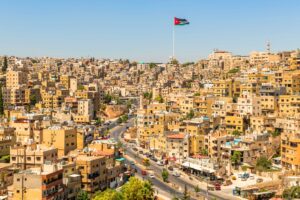Threats of Yemen’s Houthi rebels bringing down America made by a speaker on Yemen’s al-Masirah TV captured something of the present moment in international relations. And even if the Houthis’ attacks in the Red Sea area is not the decisive blow to the US-led world economy that they envisioned, they have certainly caught the world’s attention, with about 50 attacks against ships in the Red Sea or its vicinity, through which 15 percent of all global maritime trade moves.[i]
The Houthis are part of a broader portfolio of Iran-backed armed movements, based in the Gaza Strip, Lebanon, Syria, and Iraq, among others. Hamas, Palestinian Islamic Jihad, Yemen’s Houthis (Ansar Allah), Iraq’s Kataib Hezbollah and Asaib Ahl al-Haq, and a slew of small Syrian militias are extremely violent and increasingly aggressive. A million people or more have died in Iran’s clients’ wars in the Middle East in the past decade. These groups have also shelled US bases in Syria and Iraq 170 times, and killed three American soldiers.[ii] Armed with Iran’s sophisticated weapons, they have used guided missiles and/or drones to hit the Dubai international airport and also Saudi Arabia’s biggest oil facility. If anything, these groups appear to be getting both bolder and better armed as time goes on. Why are they so determined to set the Middle East on fire, and what can the US and its allies do to stop them?
The parallel economy and organization of militant groups
These groups are certainly terroristic in their methods. But they are not al-Qaeda or the IRA—they control territory and have tens or hundreds of thousands of people on their payroll. Their leaders are wealthy men who own extensive commercial real estate holdings. These terror chieftains’ willingness to kill and be killed is very genuine, but these are not men on the run, they are men on the make—and for many of them, amassing more wealth and power seems to be a higher priority than any specific near-term political or military objective.
The other strange feature of these groups is their extreme decentralization. Iraq has over a dozen different Shia militias active in the Iran-backed Popular Mobilization Forces, as well as separate Sunni and even Christian auxiliaries. Syria has even more. The Houthis in Yemen and Lebanese Hezbollah are relatively more cohesive, although both maintain local allies—including a range of small Shia and even non-Shia armed groups in Lebanon that are allied with Hezbollah but maintain separate forces.
At this point, these groups are probably best understood neither as ideologically motivated terrorists, nor as mercenaries for Iran. Rather, to make sense of what they are doing, one has to understand the environment in which they operate: poorly governed or non-governed areas of the Middle East, where the rule of law is non-existent or extremely weak, and where internal and external threats to security are rife.
The militants take control of key parts of the economy, with a special focus on commercial real estate and import-export businesses.
In every country where they operate, these militant groups follow a similar modus operandi: taking over state institutions from the inside, and using them to enrich militia leaders and their associates. The militants fund their activities by exploiting the state apparatus, which in each of these countries somehow manages to be both bloated and ineffective at the same time. Schools, hospitals, and police stations are over-staffed, but not all staff are properly qualified, and many of them obtained their posts through personal connections, often with militant-linked networks. Sometimes these workers collect salaries but perform no work. The militants also take control of key parts of the economy, with a special focus on commercial real estate and import-export businesses—both of which are attractive because they are easy to dominate by force. In war-torn areas, foreign aid is often targeted for exploitation as well. The militants generally avoid directly seizing aid supplies (though such cases have been documented), preferring instead to act as a kind of silent partner, controlling aid groups’ decisions so that supplies go to towns and villages favored by them, and that contractors affiliated with them win tenders. Journalists or civil society activists raising awareness about these forms of illegal enrichment are arrested, kidnapped, or assassinated.
These groups are prone to imposing various kinds of extra-legal taxes and payments on the populace. In Yemen, these are a religious tax called khums, but in Syria, Lebanon, and Iraq, they are more often indirect: the population pays for the militants through their control of government contracting and payroll systems, and especially through their manipulation of import-export rules to enrich preferred businessmen—or to create a complicated set of tariffs so that smugglers with ties to security forces can profit by bringing in goods off-books. The same system actually exists inside Iran. Mahmud Ahmedinejad famously referred to this phenomenon in a 2011 speech, in which he spoke of economic problems created by “our own smuggler brothers”—a reference to the extensive involvement of Revolutionary Guards officers in smuggling of cigarettes and other goods to get around high tariffs.
In some cases, even more extreme forms of exploitation are imposed. In Syria, militias and security forces kidnap hapless residents, then demand ransoms for their release or even just for information about their fate. In Iraq, militant groups extort extra-legal tolls from truck drivers, especially on roads leading to and from border crossings. These illegal enrichment activities are so widespread and have such a profound impact on the surrounding society that they actually constitute an economic system of sorts.
Iran’s Revolutionary Guards Corps (IRGC) provides weapons, military training, and some direct funding for a few of the most professionalized militant groups.
The Iranian government does provide some funding, but for many of these groups, the cycle of depredation of victims and recruitment of unemployed youth is perfectly sustainable on its own—especially since the latter tend to come from more Shia, more rural, and less educated strata of society. Iran’s Revolutionary Guards Corps (IRGC) provides weapons, military training, and some direct funding for a few of the most professionalized militant groups. These are not “popular” resistance movements, at least not in the sense of enjoying majority public support. Rather, in each country, they rely on a minority segment of the population. Yes, the fighters are mostly Shia—but they are also mostly men from rural areas or neighborhoods populated by recent rural migrants: southern Lebanese villages, Syria’s mountainous Alawi coastal region, the marshes of southern Iraq, or the slums on the outskirts of Baghdad and Beirut. Their values are more conservative than the average person’s, and their exposure to the globalized world is less. Indeed, part of these groups’ ethos is the idea that they are somehow protecting Arab and Islamic values from American influence (what Iran calls the “soft war”).
Though nominally ideological, the structure of these groups is highly personalized. Bashar Assad, Hassan Nasrallah, and Abdul-Malik al-Houthi lead for life, as does Iran’s Khamenei. Even many of their deputies and military chiefs tend to have life-long tenures, although these have often been cut short by airstrikes or fallings out with each other. With many of these men and their families amassing vast wealth in the process, it is sometimes hard to tell where the line runs between an ideological project of militancy and a family business.
Iran-backed forces have created a militant nexus stretching across several countries, in which domestic repression and international aggression are two mutually supporting pillars. A willingness to attack American, Israeli, or Gulf Arab targets serves as almost a kind of screening mechanism, to ensure that only players willing to align themselves with Iran and accept the cost of US sanctions gain admittance.
The loose nature of these semi-state militant networks is also a necessary function of the system. In diverse societies with deep sectarian, ethnic, and tribal divisions, it is easier to recruit localized militant groups than to form a national army. The mafia-like revenue structure of these groups also lends itself more to a loose, semi-hierarchical structure. International sanctions and US and Israeli airstrikes may also reinforce this tendency, making leaders prefer a distributed organization and leadership structure which presents fewer clear targets, and which is harder to dismantle or subvert.
Seen in this light, the commonalities among these disparate groups become more clear, making it easier to understand the nature of their connection to Iran and to each other. Syrian militias, often Alawite and operating under relatively tight supervision from the Baathist government, are in fact engaged in a similar enterprise to Shia Islamist groups operating almost independently of Iraq’s elected government. What unites them is a common domestic position as parasitic entities sucking revenue out of society, and an international posture as part of an Iran-led anti-Western, anti-Sunni axis. Syria’s Assad is a head of state, Hamas’ Yahya Sinwar leads a militant group while Hezbollah’s Hassan Nasrallah leads a political party—but all three men are engaged in building up militia forces and enriching their confidantes while letting formal institutions in the territories they control decay. All three men believe, or purport to believe, that their approach of enriching militant networks while impoverishing the population is part of a broader project of defeating Western, Israeli, and Gulf influence in the region.
Seen in this light, it is unsurprising that militants have increasingly been turning their sight beyond their own borders. Attacks on Saudi Arabia and the UAE are designed to extort concessions, not just in military or diplomatic terms, but also in terms of funding for Yemen, where Houthis get a share of government revenue, or for reconstruction projects in Syria and other similar revenue streams which the militants can access.
Iranian advisors play a direct and critical role in coordinating attacks on US and other foreign targets, always trying to ensure that they avoid a massive retaliation that might endanger these groups’ existence or control. For Iraqi or Yemeni militants with little formal education and limited foreign travel experience, Iranian advice is vital to helping navigate security, finance, and diplomacy. Iranian advisors also de-conflict when competing groups fall into disputes about turf, prestige, or control of specific revenue streams.
The Iranian model exported
Another notable feature of this system is the growing resemblance between the social and economic systems of Iran and its proxies. Once one of the Middle East’s most modern states, Iran is starting to look like Syria—a poor country with a weak, ineffective, and nearly bankrupt state, and a massive wave of emigration, especially among the educated classes. Political and economic power are increasingly centralized in the hands of a small set of interlocking cliques, whose members are drawn heavily from the army and security services, and who grew up in peripheral rural areas. US sanctions impoverished the country, while simultaneously making its economy even more opaque, further enriching a small circle of government-linked warlords and sanctions-busting middlemen.

Comparative GDP per capita of Iran and Syria in US dollars (source: World Bank[iii])
The countries that have fallen under the sway of Iran’s “resistance axis” now find themselves mired in a level of poverty and social conflict not previously seen in the modern Middle East. They are increasingly looking like the most war-riven countries in the world.
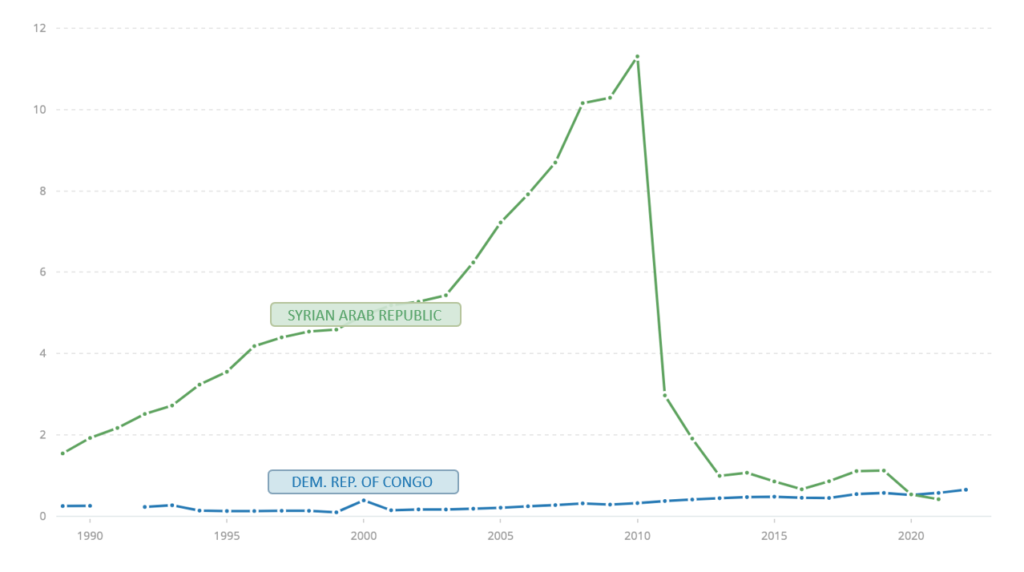
Comparative GDP per capita of Syria and the Democratic Republic of Congo in US dollars (source: World Bank[iv])

Comparative GDP per capita of Lebanon and Myanmar in US dollars (source: World Bank[v])
One helpful way to conceive the system Iran and its clients have created is as a kind of modern re-invention of medieval feudalism. Local leaders recruit fighters to wage war against outsiders and participate in upholding religious values by persecuting religious minorities or alleged heretics and sinners. In return, these warband leaders gain broad autonomy and the ability to extort from residents on their home turf. At the top of the pyramid is a nominally all-powerful leader. This leader’s state apparatus handles relations with other countries, mints the currency and imposes some basic guidelines. But otherwise, it leaves local chiefs to act as they see fit—and sometimes even gives them exclusive control of specific revenue streams, like a port, a border crossing, or a government ministry. Religious rhetoric and the occasional crusade provide some limited form of regime legitimation.
The usual Western toolkit of sanctions, assassinations of key leaders, and strikes on military infrastructure seem to achieve at best limited, short-term results.
Aggressive conflict with outsiders is essential for the legitimation of this system. Endless war abroad and chaotic oppression at home go hand in hand, as the decentralized network of militants is well suited to enabling international terrorism. The usual Western toolkit of sanctions, assassinations of key leaders, and strikes on military infrastructure seem to achieve at best limited, short-term results. Like a pathogen responding to a partial course of anti-biotics, these groups may actually become stronger and more dangerous as the surviving militant leaders adapt. Sanctions and strikes certainly have their place, but they need to be embedded in a broader strategy. That strategy will have to treat Iran and its proxies as a geopolitical rival, similar to Putin’s Russia or Xi’s China—but while also retaining flexibility to deal with each country in a manner that makes sense in light of its particular circumstances.
Iran’s neo-feudal warlordism is designed with one of its primary aims making its constituent groups resistant to sanctions, airstrikes, and other traditional US and broader Western responses. This does not make Iran and its clients unstoppable—but it does require some new thinking about how to approach the problem. In particular, Western policies could benefit from:
- Ignoring hollow states, and focusing on networks. The US policy debate is torn between those who want to deal with Iran and its proxies through negotiations and those who want to deal with them through war. But the very concepts of war and peace are undermined by the way Iran and its clients operate—militant networks exploit and often control state institutions, but they are not the state itself. No amount of aid will strengthen the state in a place like Lebanon to deal with these actors, nor will bombing alone “convince” the state to crack down on militants. Normal state-to-state relations with Syria, Iran, Lebanon, or any Houthi-controlled government in Yemen are not possible at this time. That does not entirely rule out negotiations with specific leaders or groups, but it is important to understand that, in these environments, it is non-state actors who are in the driver’s seat of conflict. Carrots and sticks wielded by the US and its allies need to directly impact these networks, not the states that they are parasitically exploiting.
- Damaging militant finances through structural changes. Over the longer term, the US should seek to change the economic environment in which this brand of Iran-backed neo-feudalism thrives. What economic power Iran’s clients still possess depends heavily on their ability to siphon off wealth from the international system. Often this is through stealing international aid, or controlling how it is distributed. Foreign aid can be a surprisingly important revenue stream in war-torn countries. In Yemen, for example, the World Food Programme’s planned aid of $2.9 billion for 2024 is equal to about 25 percent of all revenues of the Yemeni government for 2019 (the last year for which data or available)—for both the central authority and Houthi-controlled areas. But there are also more complex ways that the militants use points of contact with the outside world for enrichment. In Iraq, Iran-backed groups have used their influence on the government to manipulate the Central Bank of Iraq’s dollar exchange systems, although this has gotten harder lately due to tightened US enforcement of anti-money laundering rules. Across these countries, remittances from emigrants and refugees living abroad constitute an enormous share of economic activity—and corrupt authorities demanding bribes are able to claw back a significant share of these inflows. US regulators should be working systematically to make it harder for the militants to take control of foreign funds coming into their territory, whether as aid or in other ways. Sanctions on the worst actors engaged in this kind of corruption may be helpful, but it is also important to encourage the creation of some islands of normal economic activity—whether these be actual safe zones like non-Houthi controlled Yemen, or simply commercial or government institutions in Iraq or Lebanon that are free of Iran-backed groups’ influence. The US should carefully monitor and hit back hard at militant groups’ efforts to subvert or destroy wherever such institutions remain. It should also consider insisting on changes to the way that international aid groups operate in militant-held territories to prevent aid funds from being stolen or mis-directed. Creative thinking is also needed about how to use trade policy and regulation to subvert the militants’ economic networks—but this discussion is perhaps better kept to non-public forums, to preserve the element of surprise.
- Keeping the global context in mind. Through Iranian weapons sales to Russia and Russian intervention in Syria, the Iran-led axis has become intimately connected to the broader war on the existing international order. China has become a critical investor in Syrian reconstruction projects and in Iraqi oil, partly because Western companies are reluctant to get involved in these countries while sanctions are still in place. Iran, Russia, and China have different ideologies, but a shared vision of a world with a competing model of international relations in which authoritarianism is tolerated more. Given their shared interest, prying Iran and its allies away from China and Russia seems unlikely—as does enlisting China to reign in Iranian aggression. As with Russia and China, so with Iran, democratic countries will have to find ways to check their ambitions and deter their threats, for quite some time to come.
[i] Vergun, D. (2024). “DOD Takes Steps to Restore Stability in Red Sea Area,” 27 February, retrieved from: https://www.defense.gov/News/News-Stories/Article/Article/3688761/dod-takes-steps-to-restore-stability-in-red-sea-area/.
[ii] Seligman, L. (2024). “Iran proxy attacks on US troops in Iraq, Syria drop off as Red Sea heats up,” 6 March, retrieved from: https://www.politico.com/news/2024/03/06/proxy-attacks-iraq-syria-red-sea-00145428.
[iii] World Bank (2024). “GDP per capita (current US$) – Syrian Arab Republic, Iran, Islamic Rep.,” retrieved from: https://data.worldbank.org/indicator/NY.GDP.PCAP.CD?locations=SY-IR&most_recent_value_desc=false.
[iv] World Bank (2024). “GDP per capita (current US$) – Congo, Dem. Rep., Syrian Arab Republic,” retrieved from: https://data.worldbank.org/indicator/NY.GDP.PCAP.CD?end=2022&locations=CD-SY&start=1989.
[v] World Bank (2024). “GDP per capita (current US$) – Myanmar, Lebanon”, retrieved from: https://data.worldbank.org/indicator/NY.GDP.PCAP.CD?end=2022&locations=MM-LB&start=1988.


